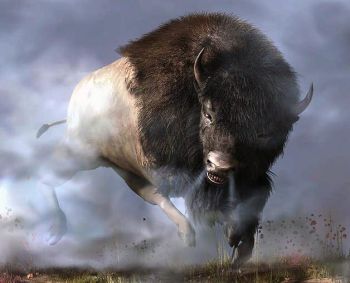Difference between revisions of "Buffalo"
Tao alexis (talk | contribs) |
Tao alexis (talk | contribs) |
||
| Line 14: | Line 14: | ||
| THAC0 = 18 | | THAC0 = 18 | ||
| hpdie = 2d6 | | hpdie = 2d6 | ||
| − | | attack = | + | | attack = '''2''': [[Horns (attack)|horns]] |
| − | | dmg = | + | | dmg = horn (2-9) |
| − | | special = [[Charging|charging]], [[Trampling|trampling]] | + | | special = [[Charging|charging]], [[Incidental Damage|incidental<br>damage]], [[Trampling|trampling]] |
}} | }} | ||
| − | + | Buffalo are large mammals dwelling on the steppelands of North America, absent in their natural state in the Old World. As nomadic grazers, they travel in herds, some of which may be up to 100 times greater than the number shown appearing. Females are found travelling together in the larger herd, which includes young between the late spring and summer. The male herd is typically a third the size of the female and is typically nearby and in sight. | |
| − | |||
[[File:Buffalo.jpg|left|350px|thumb]] | [[File:Buffalo.jpg|left|350px|thumb]] | ||
| + | __TOC__ | ||
| + | Enormously abundant, they are hunted by native and elven peoples using sophisticated techniques, utilizing strategies like the buffalo jump, where they herded the animals off cliffs, or communal hunts where the entire community participates in the process. These animals provide not only a critical source of food but also materials for clothing, shelter, and tools. | ||
| − | Buffalo are | + | == Behaviour == |
| + | Buffalo are diffident and timid; if approached, they simply stroll away at two hexes a round. If approached [[Movement (stride)|warily]], the animal might allow the character to place a calm hand upon its immense body. Yet after a few rounds, the animal trots away to a distance of 16 to 25 [[Combat Hex|hexes]]. On a 1 in 6, it and a good portion of the herd might lope away at stride-4 to stride-7 for a dozen rounds or so, until they feel safe. | ||
| − | + | Before charging, the male buffalo drops it's head and stands its ground. Should this happen, expect others to move away, as buffalo don't charge as a group. If it's struck for [[Damage (hit points)|damage]] at this point, before making its charge, there's a 50% chance the animal will take flight instead. A buffalo won't stand and fight; following it's charge, it gives ground and rejoins it's herd. | |
| − | == | + | == Advantages == |
| + | '''Charging.''' When a buffalo [[Charging|charges]], it receives a +2 bonus to hit and +3 additional damage with each striking horn. Creatures in close proximity to the charging buffalo are susceptible to incidental damage. Those who become stunned by the animal are forced to the ground by the buffalo's weight, where they suffer 2-12 additional '''trampling''' damage. | ||
| − | |||
| − | |||
| + | See [[Bestiary]] | ||
| − | + | [[Category: Reviewed]] | |
Revision as of 20:37, 13 November 2023
| Species | bovine |
| No. Appearing | 6–60 |
| Behaviour | herd |
| Range | steppe |
| Size | 6½ ft. at shoulder |
| Weight | 2,500 lbs. |
| Intelligence | 1 |
| Armour Class | 7 |
| Hit Dice | 5 |
| Action Points | 6 |
| Max. Stride | 19 |
| THAC0 | 18 |
| Hp/Die | 2d6 |
| Attack Forms | 2: horns |
| Damage | horn (2-9) |
| Special Attacks | charging, incidental damage, trampling |
Buffalo are large mammals dwelling on the steppelands of North America, absent in their natural state in the Old World. As nomadic grazers, they travel in herds, some of which may be up to 100 times greater than the number shown appearing. Females are found travelling together in the larger herd, which includes young between the late spring and summer. The male herd is typically a third the size of the female and is typically nearby and in sight.
Contents
Enormously abundant, they are hunted by native and elven peoples using sophisticated techniques, utilizing strategies like the buffalo jump, where they herded the animals off cliffs, or communal hunts where the entire community participates in the process. These animals provide not only a critical source of food but also materials for clothing, shelter, and tools.
Behaviour
Buffalo are diffident and timid; if approached, they simply stroll away at two hexes a round. If approached warily, the animal might allow the character to place a calm hand upon its immense body. Yet after a few rounds, the animal trots away to a distance of 16 to 25 hexes. On a 1 in 6, it and a good portion of the herd might lope away at stride-4 to stride-7 for a dozen rounds or so, until they feel safe.
Before charging, the male buffalo drops it's head and stands its ground. Should this happen, expect others to move away, as buffalo don't charge as a group. If it's struck for damage at this point, before making its charge, there's a 50% chance the animal will take flight instead. A buffalo won't stand and fight; following it's charge, it gives ground and rejoins it's herd.
Advantages
Charging. When a buffalo charges, it receives a +2 bonus to hit and +3 additional damage with each striking horn. Creatures in close proximity to the charging buffalo are susceptible to incidental damage. Those who become stunned by the animal are forced to the ground by the buffalo's weight, where they suffer 2-12 additional trampling damage.
See Bestiary
